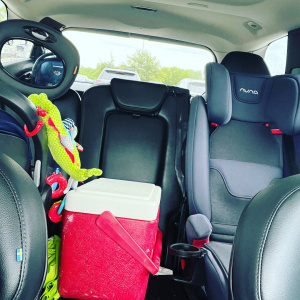Eating and Feeding On the Go

The Car Cooler
Before I became a parent, I used a cooler for beach and fishing trips only. Now its become a year-round staple in my car, nestled between two car seats. Even if your kids are much older and don't need a car seat, hear me out as I explain to you how simple and helpful this cooler can be to keep stocked as you go about your day feeding and hydrating yourself and children.
Why You Need One
Last summer, North Texas got an average of 47 days above 100'F. That was the fourth hottest summer on record. The car temperatures were well above 115'F parked. My kids and I sweated to and from our destinations and kept cool thanks to a well stocked cooler. There were no meltdowns, no waiting to arrive at our destination to get hydrated with something cool and most importantly, we always had a food safe place to store half-eaten lunches, snacks, juice pouches, and impromptu roadside farm stand finds.
What Goes In the Cooler
I purchased a few versions of the cooler, opting first for a large one to keep in the trunk but that was quickly replaced by the smallest 7 quart hard backed version due to accessibility issues. It needs to be something you can physically reach and tote inside your home twice a day when you travel with it. Here's what gets stashed in the cooler each morning before we leave for our day:
- 4 6x4" reusable frozen ice blocks
- 3 versions of hydration for each kid and adult in the car (ex: 2% milk boxes, 100% juice boxes, seltzer water)
- 2 versions of cold snacks for each kid and adult in the car (ex: hard boiled egg pre-peeled, squeezable yogurt, applesauce pouches, cheese sticks, baby carrots, cherry tomatoes, sliced cucumber)
- 3 empty silicone resealable bags (for leftovers, food we might buy on the go, or to contain messes)
Each evening/afternoon when we return home, this cooler comes back inside and the reusable frozen ice blocks go back into the freezer. The silicone resealable bags go directly into the dishwasher on the first rack. Because this is a small cooler, its easy to wash and rinse the inside and throw away any leftover food.
Stocking Your Cooler
As a dietitian, I know how important planning can be to stay on track with healthy eating goals. That is why I work from reoccuring pantry and grocery lists that keep my home stocked with the foods and beverages my kids and family consume routinely. When par levels go down, we use a combination of delivery grocery options that come directly to our home and weekly trips to a grocery store. The snacks that I mentioned go into the cooler are chosen for a very specific reason: lean proteins and vegetables are hardest to find on the go as opposed to carbohydrates and fats. We parcel these foods out routinely in silicone reusable bags as soon as they come into our home from the grocery store. Afterwards the bags are kept in a crisper drawer in the refrigerator. Packing the cooler takes less time this way as does teaching my oldest child to self-serve out of the crisper whenever it is snack time.
A Word About Food Safety
Food that isn't stored in your refrigerator and guaranteed to be kept at 40'F or colder are at risk for harboring bacteria. This means you need to be smart about the temperature of your cooler. If you forgot to take it in one night and restock the ice or icepacks, you need to throw away the food and beverages that were left inside it. It is not worth the risk of getting a food borne illness.

 RSS Feed
RSS Feed